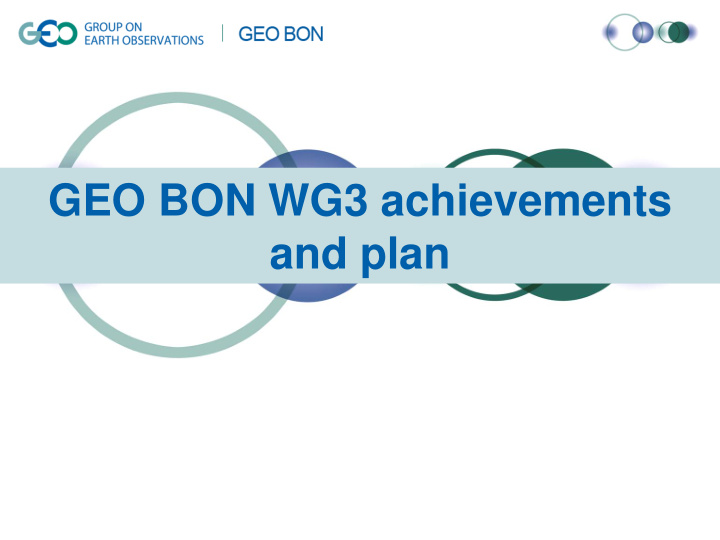



GEO BON WG3 achievements and plan
Aims WG3 • Harmonise ecosystem mapping and monitoring • Stratify a global network of Biodiversity Observation Sites to reflect major global environments and threats • Coordinate (with WG2) to extend standardised monitoring using appropriate sampling methods • Create an infrastructure, methods and shared protocols to provide consistent datasets and biodiversity knowledge at different spatial and temporal scales • Focus on capacity development and user engagement.
WG3 achievements (EBONE) 1. Global stratification scheme a) Allows area-weighted aggregation of unequally-intense samples b) Permits gap identification and filling c) Consistent with the GEO global ecosystem task, but not fully convergent
Represenativeness Europe biases: Mediterranean and Alpine North under represented Urban and peri-urban region under represented Economic density Euro / km 2 Metzger et al., JEM 91: 1357-1365
WG3 achievements (EBONE) 2. General Habitat Categories 1. Life form composition provides an operational basis for terrestrial ecosystem classification 2. Lends itself to linkage with remotely sensed observations 3. Consistency with LCCS an advantage
WG3 achievements (EBONE) 3. Sampling strategy a) The 1x1 km square with 400 m 2 minimum mapping unit b) Appropriate stratification 4. Interoperability tools a) Field and lab data protocols b) Open source codes for analysis and integration c) Warehousing approaches
WG3 achievements (EBONE) 5. Remote sensing and airborne methods – LiDAR for life form structure – Phenology and spectral features for function
Global Environmental Stratification – details J4 (cool temperate and moist) Links Brittany and Cornwall G8 (cold mesic) Links Apenines with other mountain regions L6 (warm temperate and xeric) Links the hottest parts of Spain with Africa
WG3 achievements (EBONE) 6. Connectivity and fragmentation measures – Area, matrix, edge, configuration, connectivity
What is still needed? 1. Terrestrial Ecosystem Change Monitoring Handbook – Required to harmonize data collection efforts – Basis for capacity building – Funding through Horizon 2020 – Collaboration across WGs 2. Ecosystem related Essential Biodiversity Variables (EBVs) – Definition and elaboration of the EBV concept – Practical need to link and compare EO and in situ data – Basis for capacity building – Link to other WGs – Link to task 1. Monitoring Handbook 3. Derivation of key Essential Biodiversity Variables (EBVs) at a regional/global scale from EO – Demonstration and implementation of EBV concept – FP7 proposal – Horizon 2020 funding
What is still needed? 4. Global stratified network of Biodiversity Observation Sites reflecting major global environments and major threats to biodiversity – in situ ecosystem change monitoring system – knowledge from ILTER, BirdLife, IUCN, CAS, CBMP, BIOTA projects etc – Link to WG7 5. Shared protocols to provide consistent datasets and knowledge based at different scales – Reference material – Complements the handbook – Uses existing material available worldwide; thus facilitating collaboration in a global context and will be web based linking in situ and RS methods – A-Globe-II proposal?
What is still needed? 6. In Europe GEOBON WG3 will develop and promote the INSPIRE/EUROGI principles of data sharing infrastructure and open data policies; – Policy documents + standards preparation – Contribute to the lobby and preparation of policy to ensure open data access and data sharing infrastructure – Complements and supports INSPIRE, EUROGI 7. In the Americas GEOBON WG3 will develop and promote the FGDC, PC-IDEA, GEOSUR/CAF/PAIGH principles of data sharing infrastructure and open data policies – Same idea as 6, but focussed on the Americas – FGDC, PC-IDEA, GeoSUR/CAF/ PAIGH – knowledge and access to key policy instruments and documents, plus technological development
What is still needed? 8. Global Capacity building programme to fill knowledge gaps, share knowledge, tools and methodologies – Design capacity development level relevant to target groups – A core curriculum – Development and adaptation of technology for data as well as data using the latest IT developments, tablets and smart phones as input devices to automate data collection – Cooperation with WG 4 9. Standardized 250 m Global Ecosystem Map – A new map of global ecosystems at a 250 m spatial resolution – landforms, lithology, bioclimate, and surface moisture
Further ideas • Integration of EO data and biodiversity observations into habitat/species distribution models, particularly the 3D and temporal components. • International coordination (similar to GEO-FCT etc.) to promote routine use of EO data in biodiversity observation and monitoring, with responsibility to countries. • Coupling of biomass (carbon) and structural assessments currently occurring with biodiversity observations and monitoring. • Prioritising among deliverables based on need: • Mechanism to feed into real world decision making • How do we link WG3 outputs with global ecosystem change modelling?
Recommend
More recommend